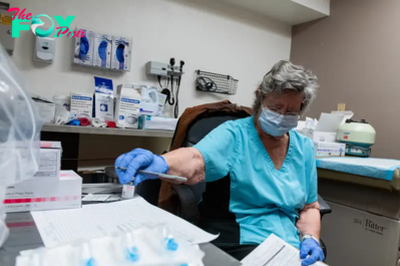Health
Colorado is among the slowest in the nation at food assistance — and its dysfunctional technology is part of the problem
Here’s what the state’s long-troubled Technology system cost Jefferson County when it malfunctioned again last week: about one-third fewer applications for food assistance and other aid were processed compared with an average day, meaning help for about 200 people was delayed even longer.
And that’s just one county.
Colorado’s 11 largest counties miss out on helping about 850 families for every 30 minutes that the Colorado Benefits Management System is not functioning. So for the 73 hours from April to December that the system collapsed, that’s 124,000 families, according to a tally by Colorado Counties Inc.
The delays mean some families go without help buying food for a month or longer.
The technology problems Aug. 22 were particularly frustrating for Jefferson County, which has been flooded with food assistance applications in the past year and is requiring employees to work overtime to process them all. The county last month had the lowest percentage of new applications for the Supplemental Nutrition Assistance Program — or SNAP — processed in Colorado in the time required by federal law, at just 46%.
Colorado is under a federal corrective action plan because of its food assistance processing times, which rank among the bottom five states in the nation. Households should be able to receive food assistance within 30 days of filing applications and within seven days for expedited applications. Colorado was ahead of only Kansas, Florida, New York and Georgia, along with Guam, the Virgin Islands and Washington, D.C., according to the U.S. Department of Agriculture’s report for fiscal year 2023.
The reasons include major increases in people applying for help since the pandemic and not enough staff to handle the workload. But a Colorado Department of Human Services effort to help counties clear the backlog is up against an even more intractable problem — the state computer system that manages government benefits, from Medicaid to child support to burial assistance.
State workers have groaned or rolled their eyes for two decades at the mention of the Colorado Benefits Management System, or CBMS. The legislature’s Joint Technology Committee, a year-round panel of six lawmakers, heard testimony this summer on the system’s widespread problems.
Colorado for years has patched up problems but avoided a total overhaul. The state is budgeted to spend more than $102 million on CBMS this year, including vendor contracts and IT support.
The system, launched in 2004, involves more than 30 vendors and 700 websites. It holds information for 1.25 million Coloradans on Medicaid health insurance, 599,000 people receiving food assistance and 17,000 people on adult financial assistance.
When a part of the system malfunctions, it’s up to the vendor in charge of that part to fix it.
System problems cause havoc for all of Colorado’s welfare programs, though the problems decreased from 317 hours when the system was malfunctioning in 2022 to 138 hours in 2023, according to the two state agencies that use it most, the Colorado Department of Human Services and the Colorado Department of Health Care Policy and Financing. Total outages, however, are already at 20 hours so far this year, up from 18 hours in 2022, the departments said.
The human services department has two years’ worth of backlogged and unscheduled fixes and updates to the system, including 35 just for SNAP, formerly known as food stamps, according to a presentation to the legislature’s technology committee.
Colorado Counties Inc., a nonprofit association for all counties in the state, wants lawmakers to order a third-party review of the system and determine whether it “can be fixed or should be replaced.”
Colorado improves statewide average to 88%
Colorado is now processing 88% of its new applications for food assistance and 87% of its renewals on time, up from a statewide average of about 75% last year, said Shelley Banker, director of the Office of Economic Security at the state Human Services department. That’s still not enough to get off the corrective action plan with the U.S. Department of Agriculture, which wants states to reach 95% compliance.
And Colorado’s statewide average masks the fact that some counties are struggling.
In San Juan County, officials in the county seat of Silverton had just one new application for food assistance in July and didn’t process it within 30 days as required, giving them a score of 0%. San Juan County officials did not respond to a request for comment about what happened.
And in Costilla County, one of the poorest counties in the state, officials in San Luis were able to process only 18.8% of new applications and 52.7% of renewals on time.
Costilla County’s eligibility supervisor Pamela Taylor said the county is struggling with ongoing problems with the state technology system and staff turnover. The county of 3,600 people has also seen a rise in welfare requests, and now has 2,209 people receiving SNAP. “Costilla is a county that, due to cheap land and legalized marijuana, many off-gridders find their way here, and once here request benefits, which significantly impacts our caseloads,” she said via email.
-

 Health56m ago
Health56m agoThe Surprising Benefits of Talking Out Loud to Yourself
-

 Health2h ago
Health2h agoDoctor’s bills often come with sticker shock for patients − but health insurance could be reinvented to provide costs upfront
-

 Health17h ago
Health17h agoWhat an HPV Diagnosis Really Means
-

 Health23h ago
Health23h agoThere’s an E. Coli Outbreak in Organic Carrots
-

 Health1d ago
Health1d agoCOVID-19’s Surprising Effect on Cancer
-

 Health2d ago
Health2d agoWhat to Know About How Lupus Affects Weight
-

 Health5d ago
Health5d agoPeople Aren’t Sure About Having Kids. She Helps Them Decide
-

 Health5d ago
Health5d agoFYI: People Don’t Like When You Abbreviate Texts



























